|
|
|
Sort Order |
|
|
|
Items / Page
|
|
|
|
|
|
|
| Srl | Item |
| 1 |
ID:
100027
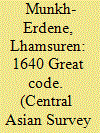

|
|
|
|
|
| Publication |
2010.
|
| Summary/Abstract |
Two recent studies, Johan Elverskog's Our Great Qing (2006) and David Sneath's The Headless State (2007), have made bold and fascinating contributions to overcoming the lingering legacy of representing and framing the pre-modern Inner Asian social and political order in terms of evolutionist, nationalist or nation-statist logics. Joining the cause and building on these works, yet critically examining them, this article argues that the late sixteenth and early seventeenth-century Mongolian political order was akin to that of the Holy Roman Empire and the 1640 Great Code was an Inner Asian parallel to the Treaty of Westphalia.
|
|
|
|
|
|
|
|
|
|
|
|
|
|
|
|
| 2 |
ID:
159758
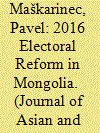

|
|
|
|
|
| Summary/Abstract |
This article tests the effects of a new electoral system that was introduced in Mongolia for the June 2016 elections. The decision to implement a first-past-the-post (FPTP) system instead of a mixed-member majoritarian (MMM) system, which was first and last used in the previous elections of 2012, was due to the April 2016 ruling of the Mongolian Constitutional Court on unconstitutionality of the list tier as one of the mechanisms for distributing seats within MMM. Through an analysis of national- and district-level results, this article addresses the question whether electoral competition at the district level was consistent with Duverger’s law and resulted in the restoration of bipartism, which had been disrupted in 2012 due to the use of MMM.
|
|
|
|
|
|
|
|
|
|
|
|
|
|
|
|
| 3 |
ID:
157656
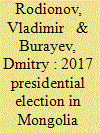

|
|
|
|
|
| Summary/Abstract |
The article analyzes the election of the President of Mongolia held in the summer of 2017. It concentrates on the foreign policy aspects of the election campaign. The main themes of the foreign policy aspect of the election were relations with Russia, China, and foreign investors. As to Russia, all candidates were unanimously in favor of drawing closer to it, but as far as China was concerned, heated discussions unfolded around the subject, which is explained by a whole range of problems existing in Sino-Mongo-lian relations.
|
|
|
|
|
|
|
|
|
|
|
|
|
|
|
|
| 4 |
ID:
119734
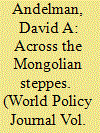

|
|
|
|
|
| Publication |
2011.
|
| Summary/Abstract |
ULAANBAATAR, Mongolia-"Before we begin, I'd like to decline two questions," the National Security Adviser to Mongolia's president warns me. "One is railroads, the other is Chinese workers." With those caveats, Batchimeg Migidorj touches on the two third-rail issues that define her nation's precarious place in the world.
|
|
|
|
|
|
|
|
|
|
|
|
|
|
|
|
| 5 |
ID:
160849
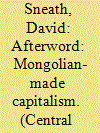

|
|
|
|
|
| Summary/Abstract |
Oligarchy (oligarhi) has become a well-worn Mongolian term for describing the social order. Real power and wealth is now said to be monopolized by a small number of super-elite families. The roots of this oligarchic capitalism lie in the process by which ownership was acquired and concentrated so as to take control of companies, rather than simply making profitable investments. The emergent form resembles Thomas Piketty's notion of ‘patrimonial capitalism’, a political economy dominated by inherited private capital, rather than the wealth created by entrepreneurship or innovation. Mongolian capitalism can also be seen as patrimonial in another sense. Its roots lie in the opportunistic struggle over a form of national patrimony: the enterprises and resources inherited from the previous political economy. The new proprietorial class already appears faintly dynastic, and presently there seem to be no barriers to the transmission of wealth to the next generation of super-rich.
|
|
|
|
|
|
|
|
|
|
|
|
|
|
|
|
| 6 |
ID:
172860
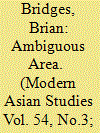

|
|
|
|
|
| Summary/Abstract |
The Mongolian People's Republic (MPR) became the focus of intense competition between the Soviet Union and Japan in the 1930s, when it was more commonly known as Outer Mongolia. The Soviet Union viewed the MPR as an ideological and strategic ally, and was determined to defend that state against the increasingly adventurist actions of the Japanese military based in northern China. Japanese ambitions to solve the so-called ‘Manmo’ (Manchuria-Mongolia) problem led the Soviets to initiate ever-closer links with the MPR, culminating in the 1936 pact of mutual assistance which was intended to constrain Japanese pressure. Using unpublished Japanese materials as well as Russian and Mongolian sources, this article demonstrates how the Soviet leadership increasingly viewed the MPR as strategically crucial to the defence of the Soviet Far East.
|
|
|
|
|
|
|
|
|
|
|
|
|
|
|
|
| 7 |
ID:
142256
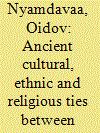

|
|
|
|
|
| Summary/Abstract |
Oidov Nyamdavaa reflects on the ancient relationship between India and Mongolia, which accounts for the many similarities between their cultures and for the spread of Buddhism to the latter and the surrounding regions. He also documents the strengthening of relations between the two countries in the modern era.
|
|
|
|
|
|
|
|
|
|
|
|
|
|
|
|
| 8 |
ID:
062065
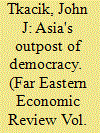

|
|
|
| 9 |
ID:
095209
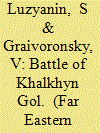

|
|
|
|
|
| Publication |
2010.
|
| Summary/Abstract |
The 70th anniversary of the common victory of the Armed Forces of the U.S.S.R. and the Mongolian People's Republic over the troops of militarist Japan and its puppet state Manchou-Go on the Khalkhyn Gol River in Eastern Mongolia was marked in August 2009. A number of functions were arranged in Russia and Mongolia devoted to this memorable date. It was not accidental that the first official visit of the Russian President Dmitry Medvedev to Mongolia was timed to the celebration of the anniversary. While handing Russian awards to Mongolian veterans Dmitry Medvedev noted that the peoples of Russia and Mongolia "would always remember our alliance and cooperation in battle and those who defeated the aggressor, upheld the territorial integrity of Mongolia and, ultimately, contributed to the rout of the enemy in the Second World War.
|
|
|
|
|
|
|
|
|
|
|
|
|
|
|
|
| 10 |
ID:
165140
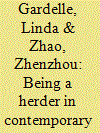

|
|
|
|
|
| Summary/Abstract |
Construction of a nomadic identity in contemporary society has received increasing attention as the result of multiple challenges, including industrialisation, the formation of nation-states and a global market system. Mongolia provides an interesting case study for examination of the self-representations of nomadic peoples and their intricate relationship with national identity-building in a developing society. Based on an analysis of 28 school textbooks on social studies subjects and the narratives of herders in two regions of Mongolia (Bulgan and Bayankhongor), this study examined the interplay between the ‘Mongol malchin’ (Mongolian herder) identity and the construction of a Mongolian national identity in the state’s dominant discourse and herders’ living experiences. The study’s findings revealed how a nomadic identity is interpreted in post-socialist Mongolian society to accommodate social changes and the political agenda of building nationhood.
|
|
|
|
|
|
|
|
|
|
|
|
|
|
|
|
| 11 |
ID:
138527
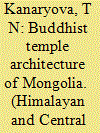

|
|
|
| 12 |
ID:
174891
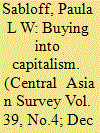

|
|
|
|
|
| Summary/Abstract |
Interviews with 864 everyday Mongolians in Hovd, Ulaanbaatar, and the surrounding countryside in 1998 and with 410 from the same locations in 2003 reveal they have an increasing appreciation of capitalism. Yet during the time of the research, Mongolians experienced economic and climatic hardships. Why would interviewees favour capitalism under such conditions? Cognitive analysis suggests that interviewees associate capitalism with the benefits of democracy, especially the economic and political freedoms gained since the demise of socialism. They anticipate not only that capitalism will allow them to improve their lives and make their own decisions but also that it will improve Mongolia’s standing in the world. Statistical analysis suggests respondents’ strong correlation between capitalism and democracy. It also suggests correlation between respondents’ perception of capitalism and risk (mostly optimism). However, their association of capitalism with democracy is greater than its correlation with risk perception. Therefore, I surmise that their love of democracy outweighs their concern for their economic future.
|
|
|
|
|
|
|
|
|
|
|
|
|
|
|
|
| 13 |
ID:
160840
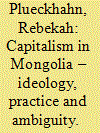

|
|
|
|
|
| Summary/Abstract |
Definitions of and understandings of capitalism are currently the source of much debate in Mongolia’s recent context of severe economic decline. This has followed the differing and sometimes contradictory perceptions of capitalism that have emerged throughout both Mongolia’s recent capitalist history and experiences of socialism. Following an anthropological, generative approach to the making of capitalist economy and drawing from Çalişkan and Callon’s discussion of economization, we explore how the economization of everyday life in Mongolia since 1990 has given rise to a context in which the economy is intensely politicized. This special issue explores the kinds of new economic practices, social formations, ideologies and subjectivities that Mongolia’s capitalist economic forms have produced. We ask what Mongolian processes of economization can tell us about the formation of capitalist economies more generally.
|
|
|
|
|
|
|
|
|
|
|
|
|
|
|
|
| 14 |
ID:
192975
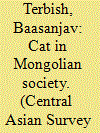

|
|
|
|
|
| Summary/Abstract |
In Mongolia the cat is viewed ambiguously. It is seen either as a good, a bad or an ugly creature, or as a mix of all these. This ambiguity stems from the cat’s function as a mirror of Mongolian society, where the transition to socialism and post-socialism was traumatic, interrupting the cosmological order. This paper explains these diverse images by analysing old legends and modern folk stories about felines.
|
|
|
|
|
|
|
|
|
|
|
|
|
|
|
|
| 15 |
ID:
183448
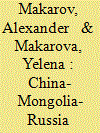

|
|
|
|
|
| Summary/Abstract |
The 100th anniversary of the establishment of diplomatic relations between Russia and Mongolia, which the two neighboring countries will celebrate on November 5, 2021, provides cause to assess the current state of bilateral cooperation, existing problems and prospects for its development.
In recent years, the intensification of Russian-Mongolian relations has been considered in the context of the trilateral Program for the Creation of the China-Mongolia-Russia Economic Corridor. Despite the lack of certain results at the moment, implementation of a number of infrastructure projects is being prepared as part of this program, which should significantly strengthen the economic base of Russia's cooperation with Mongolia and China.
This article analyzes problems of implementing plans for developing transportation and energy infrastructure through Mongolia, which are considered the basis for trilateral cooperation. Particular attention is paid to plans for developing railroad networks. Promising areas for improving transborder infrastructure within the framework of Mongolian corridor program are highlighted.
|
|
|
|
|
|
|
|
|
|
|
|
|
|
|
|
| 16 |
ID:
130638
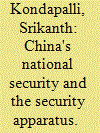

|
|
|
| 17 |
ID:
065677
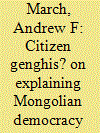

|
|
|
| 18 |
ID:
113171
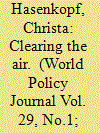

|
|
|
|
|
| Publication |
2012.
|
| Summary/Abstract |
Ulaanbaatar, Mongolia-As the sun rises over the frozen steppes, mothers and grandmothers across Mongolia emerge from their homes-white, felt-covered, round tents called gers. Hands hidden from the cold in the long sleeves of their warm deels, they clutch a ladle in one hand and an urn of milk tea in the other. Offering tsainii deej urguh, they throw a ladle-full of milk tea into the sky to honor the heavens. For many Mongolian women, the view is of blue sky and the open steppe, the horizon perhaps dotted with their family's herd of goats and sheep. But for those who live within sight of the capital, the panorama is quite different. Before them lies a vast city, home to more than a million people, jammed into an urban sprawl of closely packed gers, Soviet-era apartments, and new high-rises. Yet in the heart of the Mongolian winter, they can see none of this. Instead, a thick, gray layer of pollution obscures the horizon. Ulaanbaatar, capital of the most sparsely populated country on the planet and renowned for its pristine countryside and nomadic herdsmen, has some of the world's most toxic air.
|
|
|
|
|
|
|
|
|
|
|
|
|
|
|
|
| 19 |
ID:
160844
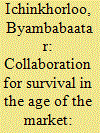

|
|
|
|
|
| Summary/Abstract |
Since 1990, Mongolia has experienced postsocialist transformation and the government-imposed ‘free market economy’. With the collapse of socialism and the former economic order, ordinary people in Mongolia have survived by engaging in diverse economic practices. The aim of this article is to give careful analysis of how people employed everyday economic practices around three key commodities – cashmere, scrap metal, and marmot pelts – to sustain their livelihoods in this postsocialist environment. Based on ethnographic field research, this article argues that social networks and kinship relations persisted through the socio-economic changes and radical reforms of the postsocialist period, creating the foundations for the diverse economic practices found in contemporary Mongolia. These practices served to distribute wealth equally and to sustain livelihoods after the government’s ‘failed’ privatization in the 1990s.
|
|
|
|
|
|
|
|
|
|
|
|
|
|
|
|
| 20 |
ID:
182699
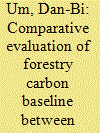

|
|
|
|
|
| Summary/Abstract |
This comparative empirical study on North Korea and Mongolia was conducted to demonstrate how satellite imagery extracted from Google Earth can be used to estimate the Reducing Emissions from Deforestation and forest Degradation (REDD) baseline. Forests in North Korea are eight times more densely distributed (8 471 787 hectares, 69.6% of its total land area) than that of Mongolia (12 842 624 hectares, only 8% of its total land area). Forests in North Korea have up to 10 times more carbon storage capacity (e.g. above-ground biomass of Pinus koraiensis under the category of the temperate continental forest, IPCC Guideline: 58.23 ton) than that of Mongolia (e.g. above-ground biomass of coniferous in boreal tundra woodland: 5 ton). Results are expected to be used as objective basic data in the process of introducing REDD+ to North Korea by verifying sharp differences between North Korea and Mongolia. The study could help companies preparing for carbon offset ventures in North Korea since it provides evidence for a more cost-effective carbon credit than in Mongolia despite less initial investment and maintenance cost for forest plantation.
|
|
|
|
|
|
|
|
|
|
|
|
|
|
|
|
|
|
|
|
|